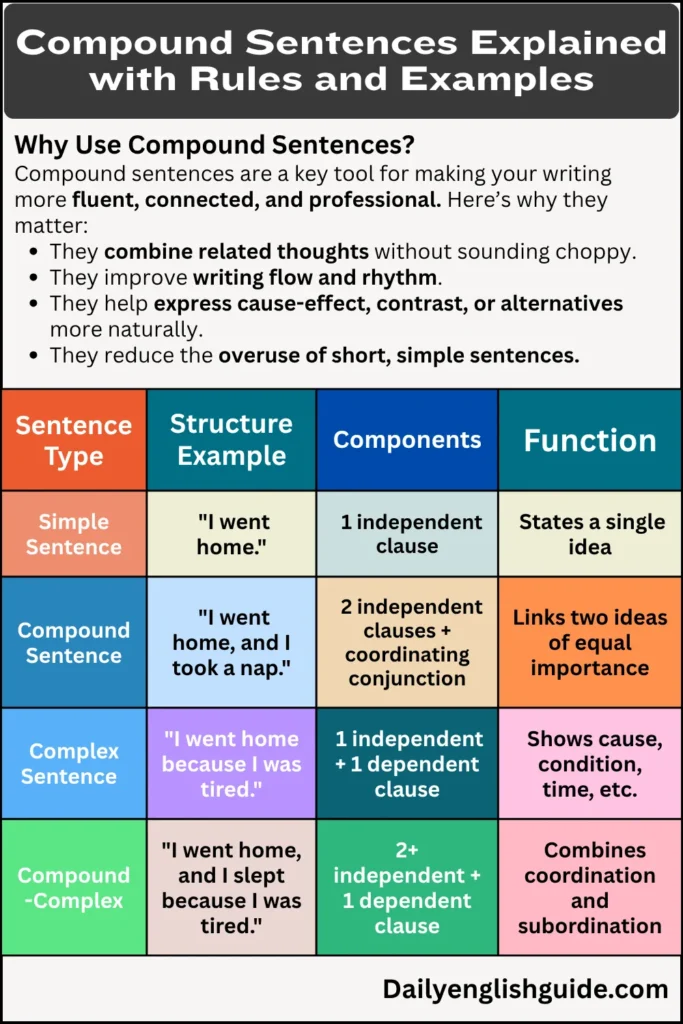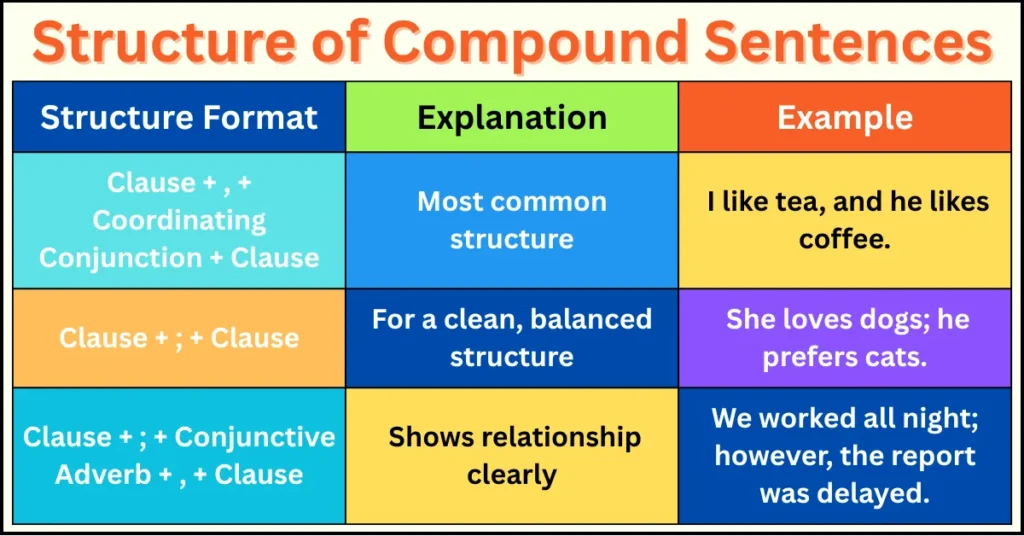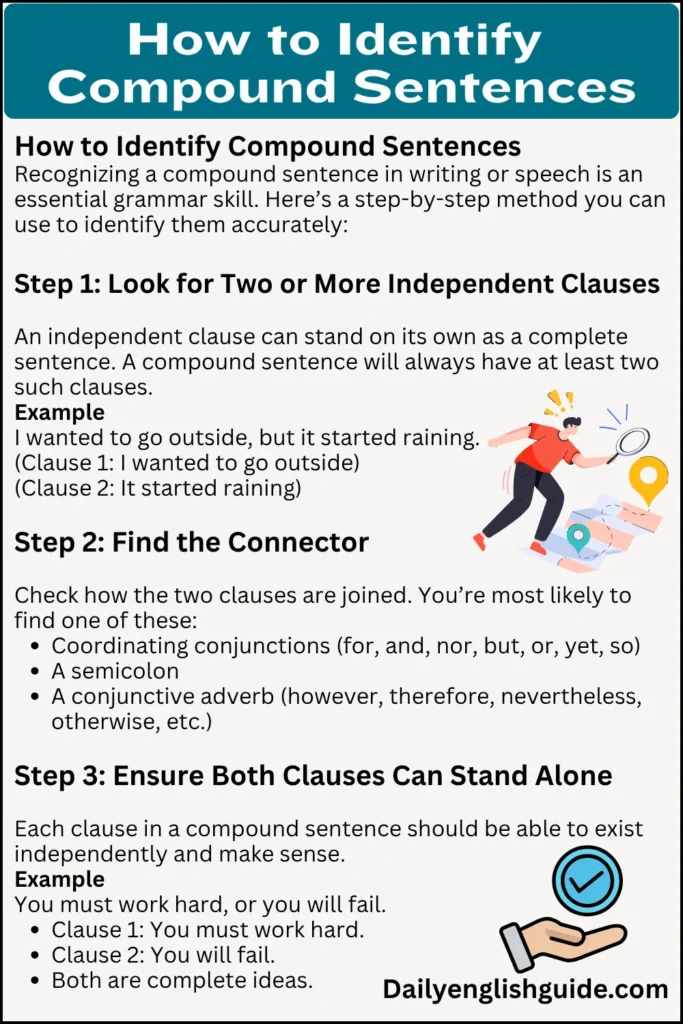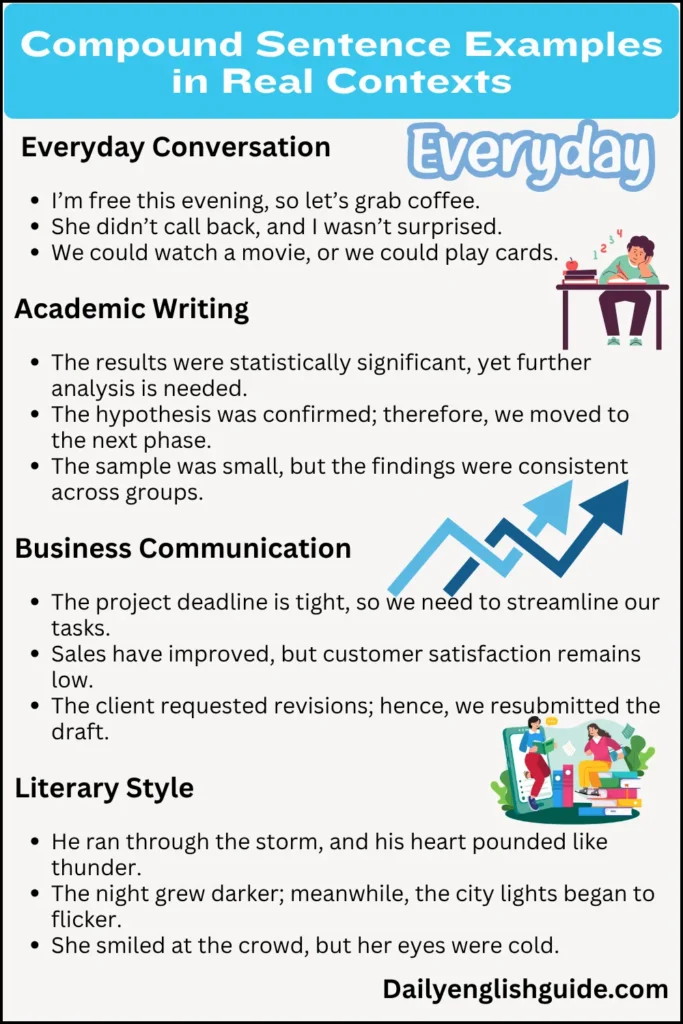If you’re learning English grammar, you’ve likely come across simple sentences. But what happens when your thoughts get more complex or you need to express two equally important ideas in one line? That’s where compound sentences come in. In this guide, you’ll learn everything about compound sentences — from their structure and punctuation rules to advanced usage with real-world examples and data-rich comparisons.
Whether you’re a student, teacher, content writer, or grammar enthusiast, this article is your one-stop resource to mastering compound sentences the right way.
What is a Compound Sentence?
A compound sentence is a type of sentence that consists of two or more independent clauses. These clauses are connected by a coordinating conjunction, a semicolon, or a conjunctive adverb.
Unlike a simple sentence (which contains just one independent clause), a compound sentence helps communicate equal importance between the clauses. Each part could stand alone as a complete sentence, but together they offer better rhythm, clarity, and flow.
Key Characteristics
-
Each clause is a complete sentence (subject + verb).
-
Clauses are joined using:
-
Coordinating conjunctions (for, and, nor, but, or, yet, so — known as FANBOYS)
-
Semicolons
-
Conjunctive adverbs (e.g., however, therefore, moreover)
-
Definition of Terms
Let’s break down some of the terms you’ll encounter throughout this article:
Independent Clause
A group of words with a subject and a predicate that expresses a complete thought. Example: “The sun set.”
Coordinating Conjunction
A word that links independent clauses of equal grammatical weight. Example: “and,” “but,” “so”
Conjunctive Adverb
An adverb that connects two independent clauses and shows the relationship between them. Example: “however,” “moreover,” “meanwhile”
Semicolon
A punctuation mark (;) used to join independent clauses when a coordinating conjunction is not used
.

Why Use Compound Sentences?
Compound sentences are a key tool for making your writing more fluent, connected, and professional. Here’s why they matter:
-
They combine related thoughts without sounding choppy.
-
They improve writing flow and rhythm.
-
They help express cause-effect, contrast, or alternatives more naturally.
-
They reduce the overuse of short, simple sentences.
Visual Comparison Table
| Sentence Type | Structure Example | Components | Function |
|---|---|---|---|
| Simple Sentence | “I went home.” | 1 independent clause | States a single idea |
| Compound Sentence | “I went home, and I took a nap.” | 2 independent clauses + coordinating conjunction | Links two ideas of equal importance |
| Complex Sentence | “I went home because I was tired.” | 1 independent + 1 dependent clause | Shows cause, condition, time, etc. |
| Compound-Complex | “I went home, and I slept because I was tired.” | 2+ independent + 1 dependent clause | Combines coordination and subordination |
Rules for Forming Compound Sentences
Creating compound sentences requires more than just joining two statements together. Follow these essential rules to construct grammatically correct and stylistically polished compound sentences.
Use a Coordinating Conjunction (FANBOYS)
When joining two independent clauses, insert a comma before the coordinating conjunction.
Example
I love writing, and I enjoy editing.
Use a Semicolon When No Conjunction Is Present
If you’re not using a conjunction, a semicolon is used to join the two independent clauses.
Example
I love writing; I enjoy editing.
Use Conjunctive Adverbs Carefully
When using a conjunctive adverb (like however, therefore, meanwhile), place a semicolon before the adverb and a comma after it.
Example
I love writing; however, I find editing more challenging.
Maintain Logical Relationships
The clauses in a compound sentence should have a clear relationship such as addition, contrast, or result.
Incorrect
I love writing, but I bought a new backpack.
(This is a weak or unrelated connection.)
Correct
I love writing, but I struggle with grammar rules.
Avoid Run-on Sentences
Make sure you don’t string together two independent clauses without proper punctuation or connectors.
Incorrect
I went home I took a nap.
Correct
I went home, and I took a nap.
I went home; I took a nap.

Structure of Compound Sentences
Here’s a detailed look at the most common structures you’ll use.
| Structure Format | Explanation | Example |
|---|---|---|
| Clause + , + Coordinating Conjunction + Clause | Most common structure | I like tea, and he likes coffee. |
| Clause + ; + Clause | For a clean, balanced structure | She loves dogs; he prefers cats. |
| Clause + ; + Conjunctive Adverb + , + Clause | Shows relationship clearly | We worked all night; however, the report was delayed. |
Examples of Each Type
With Coordinating Conjunction
-
He studied hard, so he passed the exam.
-
The bus was late, but we made it on time.
-
I can go to the library, or I can stay home.
Without a Conjunction (Using Semicolon)
-
The storm rolled in; we canceled the picnic.
-
She’s allergic to peanuts; she avoids them completely.
With Conjunctive Adverb
-
I missed the train; therefore, I took a cab.
-
He’s new here; nevertheless, he adapted quickly.
How to Identify Compound Sentences
Recognizing a compound sentence in writing or speech is an essential grammar skill. Here’s a step-by-step method you can use to identify them accurately:
Step 1: Look for Two or More Independent Clauses
An independent clause can stand on its own as a complete sentence. A compound sentence will always have at least two such clauses.
Example
I wanted to go outside, but it started raining.
(Clause 1: I wanted to go outside)
(Clause 2: It started raining)
Step 2: Find the Connector
Check how the two clauses are joined. You’re most likely to find one of these:
-
Coordinating conjunctions (for, and, nor, but, or, yet, so)
-
A semicolon
-
A conjunctive adverb (however, therefore, nevertheless, otherwise, etc.)
Step 3: Ensure Both Clauses Can Stand Alone
Each clause in a compound sentence should be able to exist independently and make sense.
Example
You must work hard, or you will fail.
-
Clause 1: You must work hard.
-
Clause 2: You will fail.
Both are complete ideas.
Step 4: Don’t Confuse with Complex Sentences
Compound sentences are sometimes mistaken for complex sentences, which include dependent clauses. The key difference is that in a compound sentence, both clauses are independent.
Compound Sentence
She called me, and I answered.
Complex Sentence
She called me because she needed help.
(The second clause “because she needed help” is dependent.)

Common Mistakes and How to Fix Them
Avoid these frequent errors when forming or identifying compound sentences:
Mistake 1: Comma Splice
Joining two independent clauses with a comma but without a coordinating conjunction.
Incorrect
He is tired, he went to bed early.
Fix
He is tired, so he went to bed early.
He is tired; he went to bed early.
Mistake 2: Missing Comma Before Conjunction
When using FANBOYS to join two independent clauses, always place a comma before the conjunction.
Incorrect
I like coffee and I drink it every morning.
Fix
I like coffee, and I drink it every morning.
Mistake 3: Weak Logical Connection
Joining two unrelated ideas makes your sentence look awkward or confusing.
Incorrect
I like music, but the apples are sour.
Fix
I like music, and I also enjoy painting.
Compound Sentence Examples in Real Contexts
Let’s move beyond textbook examples and look at how compound sentences are used effectively in different settings.
Everyday Conversation
-
I’m free this evening, so let’s grab coffee.
-
She didn’t call back, and I wasn’t surprised.
-
We could watch a movie, or we could play cards.
Academic Writing
-
The results were statistically significant, yet further analysis is needed.
-
The hypothesis was confirmed; therefore, we moved to the next phase.
-
The sample was small, but the findings were consistent across groups.
Business Communication
-
The project deadline is tight, so we need to streamline our tasks.
-
Sales have improved, but customer satisfaction remains low.
-
The client requested revisions; hence, we resubmitted the draft.
Literary Style
-
He ran through the storm, and his heart pounded like thunder.
-
The night grew darker; meanwhile, the city lights began to flicker.
-
She smiled at the crowd, but her eyes were cold.

Practice Section: Combine the Sentences
Try combining the following pairs into correct compound sentences. Use appropriate conjunctions, conjunctive adverbs, or punctuation.
-
I studied all night. I didn’t feel confident.
-
You can come with us. You can stay home.
-
He didn’t enjoy the concert. He stayed until the end.
-
The power went out. We lit some candles.
-
They tried to fix the leak. The water kept coming.
Sample Answers
-
I studied all night, but I didn’t feel confident.
-
You can come with us, or you can stay home.
-
He didn’t enjoy the concert; nevertheless, he stayed until the end.
-
The power went out, so we lit some candles.
-
They tried to fix the leak; however, the water kept coming.
Frequently Asked Questions (FAQ) about Compound Sentences
What is a compound sentence in simple terms?
A compound sentence is made up of two or more complete sentences (independent clauses) joined together using a coordinating conjunction, semicolon, or conjunctive adverb.
How is a compound sentence different from a complex sentence?
In a compound sentence, both clauses are independent (can stand alone). In a complex sentence, one clause is dependent and cannot stand alone.
Can a compound sentence contain more than two clauses?
Yes, a compound sentence can have more than two independent clauses joined using appropriate conjunctions or punctuation.
Example: He came early, she stayed late, and I left on time.
What are the most common mistakes to avoid?
-
Forgetting the comma before a coordinating conjunction
-
Using a comma splice instead of a semicolon or conjunction
-
Combining unrelated ideas
Can I start a compound sentence with a conjunction?
While stylistically debated, starting a sentence with a coordinating conjunction is acceptable in modern English, especially in informal writing. However, in compound sentences, the conjunction typically appears between the clauses.
